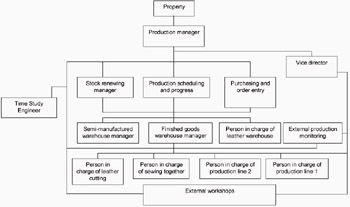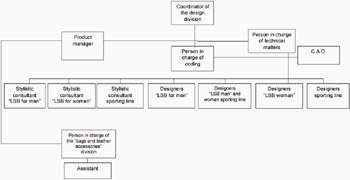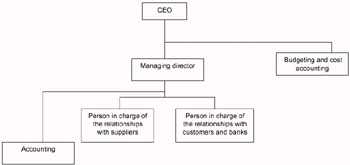BACKGROUND
|
|
History of the Organization
Founded in 1950 by the current President, LSB has now become one of the most famous shoe manufacturers all over the world. Nowadays, LSB, employing about 250 people, is a noteworthy occupational basin in an industry branch and is characterized by a multitude of very small firms and handicraft laboratories. Synonymous of high quality and fashionable shoes, LSB is situated in a little city near Milan, site of the best-known pole of the shoe industry. The firm is located in a roomy and modern building, where the administration offices and the manufacturing department find their place. Considering its dimension and the company image at the international level, LSB is one of the most brilliant realities of the sector, thanks to the three product lines offered: men and women's shoes, which generate 90% of the turnover (about $35 million in 2000), leather clothes and fashion accessories.
LSB Holding is the leader of an industrial group with 30 self owned shops, and controls "LSB Shoe Manufacturing," "LSB France S.A.," "LSB Ltd" (London), and "LSB New York Ltd.," as well as some licensees in Spain and Turkey. The share capital is entirely owned by the family who is up to the second entrepreneurship generation.
However, a trend analysis of the shoe industry shows that LSB has lost the leadership role held in the early 90s. In spite of an always appreciated qualitative production and the strong brand name during the past few years, LSB has clearly underperformed with regards to its competitors; this case study aims at investigating the possible influence of the IS management on the evolution of LSB performance.
The Company Philosophy
During its whole life, LSB has always aimed to seek a clear and coherent strategy, based upon the quest for the maximum harmony between tradition and technology in order to reach a perfect balance between quality and price. The engineering cycle is an enlightening example: shoes are designed and engineered by means of a Computer Aided Design (CAD) system to get a precise definition of all of the technical aspects ensuring the best reliability of the product. The production plant is modernly organized and equipped. Though LSB is still obliged to carry on some production phases in a handicraft way, this constraint is not felt by the firm as an obstacle to the adoption of new technological solutions. On the contrary, technology represents a fundamental strategic weapon as far as it supports LSB in increasing the gap (in terms of production volume) with the handicraft workshops.
Type of Business, Products/Services Provided
Two collections are shown every year: the spring-summer collection and the autumn-winter collection. The men's collections are divided into six lines: only one of them (the classic and stylish "LSB for men") is shown in both collections. There are four lines for ladies, with a well-known "LSB for women" standing out. In the year 2000, LSB designed about 600 models and sold about 350,000 shoes all over the world. The LSB collections are targeted towards an international customer who pays maximum attention to the quality of both the leather and the accessories used, and seeks the highest care in the manufacturing phase, as well as the best comfort possible.
Global Review of the Market
The information provided last year in D¨sseldorf during the annual "Shoe Fair" clearly showed how the shoes manufacturing branch was still loosing ground in comparison with the well-trained Asian competitors. For the first time in a long period, in 1999, the European Community (EC) production went below one billion shoes, showing a drop of 6% with regard to previous year. On the other hand, the European purchasing of shoes has shown signs of growth: per capita consumption in 1999 stood at 4.5 pairs, 3.5% more than 1998. The greatest benefit has turned at import's own advantage, showing an increase by 10.6% in the light of 898 million pairs of shoes bought from foreign countries. On the contrary, the exports, number of firms and employees experienced negative trends, recording respectively a drop of 13%, 0.7% and 4%. As noticed by Antonio Brotini, President of ANCI (National Association of Italian Shoes Manufacturers), “the sector is dealing with a crisis that brought to a decrease (13.7%) of the export towards non-EC countries due to the lengthening of the effects of the shocks that took place in Asia, then in Russia and finally in South America. It did not take long for those shocks to reflect on the Italian market so that "the adoption of new technologies," concluded Brotini, "represents an ideal scope, even if not the only one, to plan the international competitive re-launching of the sector."
Data collected by ANCI, with regard to the first half of 2000, proved that the economic climate of the shoe industry was marked by the first signs of recovery from the still situation which has characterized the sector so far. The production performance was as positive as the trend of prices, showing more awarding dynamics not only in the domestic market, but also, more important, in the foreign ones. After a painful period, shoe manufacturers could possibly look at the future with less skepticism, even if the economic climate should have led neither to a state of euphoria nor to a review of the defensive approach that, so far, had characterized the competitive strategy of the companies within the shoe industry. In fact, the competitive scope is still extremely selective and these signs of recovery were valid only for particular kinds of products.
Financial Status
Under both the profitability and the financial performance profiles during the past ten years, LSB has followed the same trend as the high-quality shoe market. After being a leader of its sector in the first 90s, LSB had to face the crisis that involved the whole industry. During last two years, LSB has been showing a recovery, even though it has lost the leadership of the Italian market, substituted by new firms established in the course of the industry crisis.
Management Structure
Organizational Charts
As shown in the organizational charts, LSB is characterized by a high level of complexity in both its group (Figure 1) and the shoe manufacturing company (Figure 2, Figure 3, Figure 4 and Figure 5).

Figure 1: Organizational Chart—LSB Group

Figure 2: Organizational Chart—The Production Function of "LSB Shoes Manufacturing"

Figure 3: Organizational Chart—LSB Commercial Function

Figure 4: Organizational Chart—The Design Function of "LSB Shoes Manufacturing"

Figure 5: Organizational Chart—The Administrative Function of "LSB Shoes Manufacturing"
|
|
EAN: 2147483647
Pages: 367